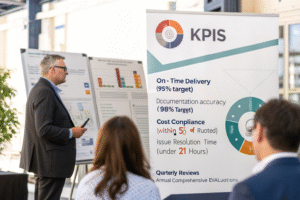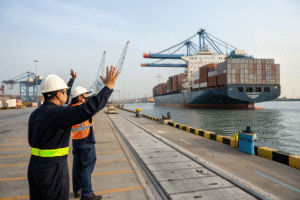When one of our clients lost $14,500 overnight due to a sudden RMB appreciation last quarter, I realized how many importers overlook currency risk. As founder of GeeseCargo, I've seen exchange rate fluctuations turn profitable orders into losses for unprepared businesses. Understanding this hidden cost factor is crucial for accurate pricing and profit protection.
Currency exchange rates directly impact your final costs by affecting product pricing, shipping expenses, and payment values. A stronger Chinese RMB increases your costs when buying from China, while a stronger USD reduces them. Most importers face 3-8% cost variance due to exchange rate movements alone.
Exchange rates represent a silent partner in every international transaction. They can erode your margins or provide unexpected savings, depending on when and how you manage the exposure. Let's examine the specific mechanisms through which currencies impact your bottom line.
How Do Exchange Rates Affect Product Pricing?
Your Chinese suppliers likely quote prices in US dollars, but they calculate their costs in Chinese Yuan. When the exchange rate moves, their real revenue changes, creating pressure to adjust prices.

Why Do Suppliers Adjust Prices Based on Exchange Rates?
Chinese manufacturers face their own cost pressures in local currency. When the RMB strengthens against the dollar, suppliers receive fewer yuan for each dollar you pay. A 10% RMB appreciation means a 10% revenue reduction for suppliers unless they increase dollar prices.
Suppliers typically absorb minor fluctuations but adjust pricing for sustained movements. Most factories review their exchange rate assumptions quarterly, passing changes to customers through price revisions. Long-term contracts often include exchange rate adjustment clauses to share this risk.
Raw material costs further complicate this picture. Many manufacturing inputs are priced in dollars, but labor and overhead remain in local currency. The net effect depends on each supplier's specific cost structure and sourcing patterns.
How Can You Anticipate Supplier Price Changes?
Monitor the USD/CNY exchange rate trend to predict supplier pricing actions. Most manufacturers tolerate movements up to 3% but seek adjustments beyond that threshold. The People's Bank of China manages the RMB within a controlled range, creating more predictability than fully floating currencies.
Build relationships with suppliers that include transparent discussions about cost structures. Understand what percentage of their costs are dollar-denominated versus local currency. Suppliers with higher local cost components are more sensitive to exchange rate movements.
Consider forward pricing agreements that lock in exchange rates for future orders. Some suppliers offer fixed pricing for 30-90 days if you commit to volume, providing cost certainty for your planning.
How Do Currency Movements Impact Shipping Costs?
Freight costs have their own currency dynamics that many importers overlook. While ocean carriers quote in US dollars, their operational costs span multiple currencies, creating complex pricing pressures.

Why Do Freight Rates Change with Currency Values?
Bunker fuel, the largest component of shipping costs, is priced in US dollars worldwide. When the dollar strengthens, carriers' fuel costs increase relative to their revenue in other currencies, creating pressure to raise rates.
Port charges and canal tolls are typically billed in local currencies or special drawing rights. Shipping lines face these costs directly and may adjust their overall pricing to compensate for exchange rate movements between collection and payment.
Labor costs for crew and port staff are paid in various currencies. A strengthening currency in a key labor market increases operational costs for carriers operating global networks. These factors combine to make freight rates sensitive to broad dollar strength or weakness.
How Can You Manage Shipping Cost Volatility?
Negotiate freight contracts with longer durations to lock in rate stability. Many carriers offer 3-12 month contracts that protect against both market rate increases and currency-driven adjustments.
Consider all-inclusive pricing that bundles various surcharges. Fuel adjustment factors (BAF) and currency adjustment factors (CAF) create unpredictability that fixed pricing eliminates. The premium for certainty is often worth the cost for businesses with tight margins.
Diversify your carrier portfolio across different geographic bases. Asian, European, and Middle Eastern carriers have different cost structures and currency exposures, providing natural hedging through diversification.
How Should You Structure Payments to Minimize Risk?
The timing and currency of your payments significantly impact your final costs. Simple changes to payment terms can dramatically reduce your currency exposure without complex financial instruments.

What Is the Optimal Payment Timing for Exchange Rate Management?
Stagger payments to average your exchange rate exposure rather than concentrating risk. Instead of a single 100% payment, consider 30% deposit, 40% before shipment, and 30% after arrival. This approach captures different rate levels throughout the production cycle.
Align payment dates with favorable historical rate patterns if possible. Some currencies show seasonal tendencies based on trade flows, capital movements, or policy actions. While not guaranteed, these patterns can inform your payment scheduling.
Use forward contracts to lock in exchange rates for future payments. Your bank can guarantee a specific rate for payments up to 12 months forward, eliminating uncertainty for cost calculations. The cost of this protection is typically 1-3% annually.
Should You Pay in USD or Local Currency?
Paying in USD transfers exchange risk to your supplier but typically comes with higher prices as compensation. Suppliers building risk premiums into their dollar pricing often charge 3-5% more than their local currency price equivalent.
Paying in RMB may secure better pricing but exposes you to exchange rate movements. Without natural offsetting RMB revenues, you assume pure risk that requires active management. This approach works best for companies with sophisticated treasury operations.
Evaluate the total cost difference between currency options, including hedging costs. The apparent savings from paying in local currency may disappear after accounting for hedging expenses and administrative burden.
What Hedging Strategies Protect Your Profit Margins?
Sophisticated importers use various hedging techniques to manage currency risk. These strategies range from simple operational approaches to complex financial instruments.

How Do Basic Hedging Instruments Work?
Forward contracts allow you to lock in an exchange rate for future dates, providing complete certainty. You contract with your bank to exchange specific currencies at a predetermined rate on a future date, typically matching your payment schedule.
Currency options provide insurance against adverse movements while preserving upside potential. You pay a premium for the right to exchange at a favorable rate, exercising only if the spot rate is worse at payment time. Options cost more than forwards but offer more flexibility.
Simple averaging strategies involve converting fixed amounts regularly regardless of rate levels. This dollar-cost averaging approach smooths out volatility without requiring rate prediction capabilities. It works well for businesses with consistent import volumes.
What Operational Approaches Reduce Currency Risk?
Natural hedging involves matching currency revenues with expenses. If you can price some exports in RMB or source inputs from countries with correlated currencies, you create natural offsets that reduce net exposure.
Strategic sourcing from countries with complementary currency movements diversifies your risk. When the RMB strengthens against the dollar, other Asian currencies may not follow exactly, providing relative cost advantages that you can exploit.
Inventory management can be tuned to currency cycles. Building stock during favorable rate periods and drawing down during unfavorable periods creates an operational hedge. This approach requires flexible storage capacity and working capital.
Conclusion
Currency exchange rates impact nearly every aspect of your international supply chain, from product costs to shipping expenses and payment values. The businesses that thrive in international trade aren't those that predict rates correctly—they're those that manage their exposure systematically.
At GeeseCargo, we've helped hundreds of clients implement practical currency management strategies that protect their margins without requiring complex financial expertise. The most effective approach typically combines supplier negotiation, payment timing optimization, and basic hedging instruments tailored to your specific risk tolerance and transaction patterns.
Remember that currency risk management isn't about eliminating exposure—it's about understanding your exposure and ensuring you're appropriately compensated for the risks you retain. By making currency management a core competency rather than an afterthought, you can transform exchange rate volatility from a threat into a competitive advantage.









